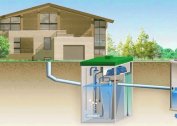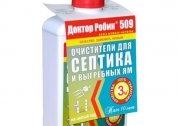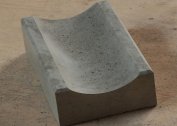To avoid flooding of technical premises - a basement or a basement, subsidence of the foundation, as well as soil erosion in the yard, you can install a gutter that will direct rainfall to the place provided for them - a ditch or storm sewer.
Definition and purpose
 The drainage system is an important element of a country house. Without it, all precipitation flows directly into the yard and creates inconvenience when moving. If you do not equip the gutters for water drainage, it will begin to melt the foundation, which will lead to its destruction. This is an additional cost for the repair and restoration of the home, which sometimes cost more than the gutter itself.
The drainage system is an important element of a country house. Without it, all precipitation flows directly into the yard and creates inconvenience when moving. If you do not equip the gutters for water drainage, it will begin to melt the foundation, which will lead to its destruction. This is an additional cost for the repair and restoration of the home, which sometimes cost more than the gutter itself.
You can do without a gutter if the roof is pent, that is, precipitation, falling on it, is diverted to the back of the house and does not cause significant damage to the walls. If the distance from the supporting structures is large enough, then the gutters are not needed at all.
Gutter device
The drainage system is a water collector located along the perimeter of the building, into which water flows from the roof. Then it goes to the funnels connected to the drainpipes. The lower end is directed into the ditches or grate of stormwater. The design is mounted under the roof so that water flows directly into the gutter without overflowing from it - for this there are special installation rules and calculations. Additional consumables - brackets and screws.
Depending on the amount of precipitation in this region, gutters of various capacities are used, as well as pipes of a larger or smaller diameter.
The design can be a one-piece factory - with corner parts or plugs so that water does not leak out and all goes to the sewer. Homemade gutters are simpler: the gutter collects water from the roof and drains it in the corners of the building. This is a less effective method, as it leads to waterlogging of the soil. In rural areas, rainfall is collected in large barrels and used to water the garden or flower beds. In rural private houses for the storage of water, rainwater drainage is specially installed.
Distinguish gutters by the material of manufacture. Here the selection is small:
- metal - copper, aluminum, galvanized steel, ordinary painted steel;
- plastic - PVC or other types of polymeric materials.
For any material, you need to choose reliable fasteners in the right amount so that the drain does not sag. This is especially important in winter when ice forms.
Materials of manufacture
There are proposals on the market for the arrangement of factory-made gutters. If you have experience and tools, gutters for draining water from the roof can be made and strengthened with your own hands. The difference in cost. The cheapest materials are plastic materials - most often polyvinyl chloride. Metal systems will be more expensive, and the most expensive material is copper. It is also the most cumbersome, so the method of fastening and the quality of the walls come to the fore when arranging a drain from copper.
Particularly strong structures are made of alloys with titanium, but at a price they exceed the budget level, therefore they are less likely.
Aluminum
Aluminum metal gutters are highly resistant to temperature changes. The material is easily bent, resistant to corrosion. The term of operation is more than 80 years.
There are disadvantages:
- low coefficient of elasticity - unstable to mechanical damage;
- expands when heated, so the joints are made with a gap so that the entire system does not deform;
- the cost is higher than that of plastic or galvanized steel;
- during installation, it is necessary to isolate all materials that are in contact with aluminum, due to high electrochemical corrosion.
The material is lightweight and does not violate the integrity of the walls.
Galvanized steel
One of the most popular materials for the manufacture of drainage systems. This is due to the flexibility due to which it is possible to make structures of varying complexity.
When using a galvanized gutter without additional coating with polymers or coloring compounds, its service life is a little more than 10 years, therefore, with the independent manufacture of structural elements, they are first cut out and then covered with a protective layer.
If the gutter is mounted after the building is built, it is made of light materials to reduce the load on the fasteners and walls. Galvanized steel is well suited for this situation, as it is light in weight.
Polyvinyl chloride
PVC is a polymer that is painted in different colors, so it’s easy to match the overall design of the facade. A home-made design can be made by cutting a pipe of the desired diameter and attaching it to the gutters. It will take more time, but cheaper.
It must be borne in mind that in the cold PVC becomes brittle. So that the water does not stagnate, a drainage slope is made inside - one-sided or two-sided. With thermal expansion, resizing is possible, so it is necessary to make gaps between the joints so that cracks do not form in the heat.
In general, the material is durable and impact resistant, withstands up to 50 years with proper use - this is comparable to the service life of metal structures. During heavy rains, water passes silently through the drain, and the inner surface does not have to be cleaned of organic film. Weight advantage - the design does not exert excessive load on the facade.
Polymer coated metal
Galvanized steel or aluminum with a polymer coating looks attractive in appearance, have a variety of colors. The layer of protective material serves as additional protection against corrosion, therefore, during installation, it must be handled with care. The slightest scratch or chip reduces the service life, as in this place the metal will begin to rust and leak.
- Galvanized steel
- PVC
- Metal with polymer
Copper Drain - Pros and Cons
Gutter systems made of copper sheets are the most durable and reliable, because the technology of seamless production allows you to make solid gutters that are not prone to breaks or cracks.
The material is not susceptible to environmental hazards. The maximum that can occur on the plates is patina, but its customers order specially, as this gives the effect of antiquity to copper products. You can create several shades of patina artificially.
A heating cable can be connected to the copper trough so that icicles do not form in the winter and snow does not accumulate. Copper can be soldered, so mechanically damaged areas are repaired or replaced. The service life of the copper roof and gutter is up to 150 years.
Copper gutters are made round or rectangular - it depends on the design and style of the facade. The softness and plasticity of the material allows you to make products of any shape from it, as well as apply for decoration.
There are 2 sizes of copper drainage system - small and large. In the first case, the width of the gutter is 125 cm, the pipe is 90 mm. In the second trench, 150 mm, pipe 100 mm.
The only drawback is the heavy weight. This requires the installation of additional fasteners for the drainpipe and reinforced fasteners for the gutter roof elements.
Gutter Dimensions
 A homemade method of galvanized steel sheets can make a gutter of any size, based on the area of the roof, its slope and the maximum amount of precipitation falling in this region.
A homemade method of galvanized steel sheets can make a gutter of any size, based on the area of the roof, its slope and the maximum amount of precipitation falling in this region.
The greater the slope of the roof, the higher the water will move downward; therefore, the gutter is deep and mounted so that the edge of the gutter 2 cm overlaps the edge of the roof.
The volume of the gutter should correspond to the amount of precipitation that falls during the rainy season.
If you make a gutter system from plastic pipes, a certain diameter is selected and sawed in half so that each half fits the calculated volume.
Installation Steps
The execution of plastic gutter systems is as follows:
- Workpieces of the required length are made. The edges of the plastic are smoothed out.
- Brackets are fastened in increments of 90 cm along the perimeter of the roof, taking into account the angle of inclination in the desired direction - to the drain pipe.
- Fittings for gutters with linear expansion are installed. Funnels are drilled.
- The gutter is placed on the brackets and fixed. In places of funnels glue or rubber sealants are used. Plugs are needed to prevent water flow in places where drainpipes are not provided. Install them taking into account the thermal expansion of the material.
- Gutters are connected to the funnels and attached to the wall. If the pipe length is more than 8 meters, the spacing of the fasteners is 90 cm.
- The end of the drain pipe is routed to the storm sewer grate. If this is not the case, then the end is lengthened to bring precipitation out of the pedestrian zone, and at the end with a candle or blowtorch make a “tear” so that the water flows in the right direction.
When arranging a gutter made of metal with their own hands, a grinder is not used, since it destroys the protective coating. All work on cutting parts is carried out using metal scissors.
The heating cable can be laid in two ways - along the lower edge of the roof and inside the gutters. This maintains a positive temperature and prevents ice formation.
Product Cost
The cheapest are constructions that are made with their own hands from aluminum, galvanized steel, plastic. The price of plastic gutters depends on the amount of material used and the complexity of the system, the number of brackets and wall mounts.
Factory models of metal with a polymer coating are more expensive - they are made to order, taking into account the size of the buyer.
The most expensive are copper drains. They are not available for free sale, since the price of the entire system is too high, and the sizes in each case differ.








